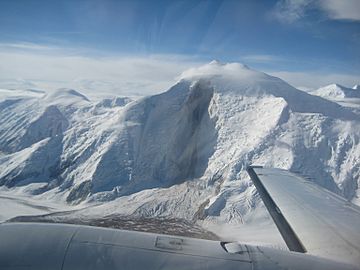Mount Steele facts for kids
Quick facts for kids Mount Steele |
|
|---|---|
 |
|
| Highest point | |
| Elevation | 5,073 m (16,644 ft) |
| Prominence | 813 m (2,667 ft) |
| Parent peak | Mount Lucania |
| Listing |
|
| Geography | |
| Parent range | Saint Elias Mountains |
| Topo map | NTS 115F/01 |
| Climbing | |
| First ascent | 1935 by Walter Wood & party |
| Easiest route | glacier/snow/ice climb |
For the mountain in Antarctica, see Mount Steele (Antarctica).
Mount Steele is a giant mountain in Canada. It is the fifth-highest mountain in Canada and the eleventh-highest in North America. This impressive peak reaches a height of 5,073 metres (16,644 ft). There is also a lower peak on its southeast side, which is about 4,300 m (14,108 ft) tall.
The mountain was named after Sir Sam Steele. He was an officer with the North-West Mounted Police. He was in charge of the police force in the Yukon during the exciting time of the Klondike Gold Rush.
Climbing Mount Steele: The First Ascent
In 1935, a team led by Walter A. Wood made the first successful climb of Mount Steele. His team included his wife, Foresta Wood, a Swiss guide named Hans Fuhrer, Joseph W. Fobes, Harrison Wood, and I. Pearce Hazard.
The climbers started their journey from the eastern side of the mountain, near Kluane Lake. They set up their main camp at the bottom of the Steele Glacier. Horses helped carry their supplies to a higher camp, called Camp 6, further up the glacier. From Camp 6, they had a great view of the mountain. They decided to climb the east ridge.
After waiting for bad weather to pass, four climbers — Walter Wood, Harrison Wood, Fuhrer, and Forbes — left Camp 8. They planned to climb 2,440-meter (8,010 ft) to the top. But heavy snow and bad weather forced them back. They had to wait five more days while over a meter of fresh snow fell!
They tried again on August 15. This time, the climb was a bit easier because the wind had made the snow harder. At about 4,570 m (14,990 ft), they reached a flat area covered in difficult snow. Walter Wood joked about it, saying it looked funny to see four people crawling across the snow at such a high altitude.
Taking turns leading the way, they slowly made their way to the top. They finally reached the summit at 2:30 PM. They enjoyed about 30 minutes of calm, windless weather at the top before starting their climb back down.
Nature's Power: Avalanches and Landslides
Mount Steele has seen some huge natural events.
On July 22, 2007, a massive avalanche happened. A huge piece of ice, about 3,000,000 cubic metres (3,900,000 cu yd) in size, broke off the mountain's north face. As it fell, it broke into smaller pieces and became a powerful avalanche. It rushed across the Steele Glacier, climbed over a 275-metre (902 ft) ridge, and kept going onto the Hodgson Glacier. It finally stopped after traveling about 8 kilometres (5.0 mi). This avalanche covered about 2 square kilometres (0.8 sq mi) of the Steele Glacier and was so big it registered as a 2.1-magnitude earthquake!
Just two days later, on July 24, 2007, an even bigger event occurred. A giant landslide happened on the north face of Mount Steele. A 400-metre (1,312 ft) wide section of ice and rock fell. Experts believe it was between 27,500,000 and 80,500,000 cubic metres (36,000,000 and 110,000,000 cu yd) in size. This landslide lasted about 100 seconds and moved incredibly fast, reaching speeds of at least 252 kilometres per hour (157 mph). It fell 2,500 metres (8,202 ft) down the mountain. It then traveled across the 1.5-kilometre (0.9 mi) wide Steele Glacier and even reached the top of a 275-metre (902 ft) ridge on the other side. It then slid back down onto the glacier. In total, it traveled about 5.76 kilometres (3.58 mi). This was one of the largest landslides ever recorded in the Yukon and western Canada.
Another big landslide happened on October 11, 2015. About 45,000,000 metric tons (44,000,000 long tons; 50,000,000 short tons) of rock, snow, and ice, with a volume of about 20,000,000 cubic metres (26,000,000 cu yd), slid 1 kilometre (0.6 mi) down the mountain. It then moved 2 kilometres (1.2 mi) across the Steele Glacier. This was one of the ten largest landslides in the world that year!
See also
 In Spanish: Monte Steele para niños
In Spanish: Monte Steele para niños


